Monthly Archives: December 2024
 This time of year, lots of people are watching the bowl games and the playoff games that are heading up to the big match…the Super Bowl. Most of these games, while very exciting, are played out according to routine. Teams win and teams lose, and the march to the Super Bowl continues on. However, on December 31, 1988, a rather unusual bowl game was played. On that day, the Chicago Bears defeated the Philadelphia Eagles, 20-12, in a playoff game. That isn’t so unusual either, except that the game was plagued by a thick fog that started up late in the first half. The game was being played at Soldier Field in Chicago and the playing conditions soon became problematic. The fog was so thick that fans in attendance and television viewers alike struggled to see the game. Eventually the game was given a new bowl name, when it was unofficially dubbed the “Fog Bowl” by media.
This time of year, lots of people are watching the bowl games and the playoff games that are heading up to the big match…the Super Bowl. Most of these games, while very exciting, are played out according to routine. Teams win and teams lose, and the march to the Super Bowl continues on. However, on December 31, 1988, a rather unusual bowl game was played. On that day, the Chicago Bears defeated the Philadelphia Eagles, 20-12, in a playoff game. That isn’t so unusual either, except that the game was plagued by a thick fog that started up late in the first half. The game was being played at Soldier Field in Chicago and the playing conditions soon became problematic. The fog was so thick that fans in attendance and television viewers alike struggled to see the game. Eventually the game was given a new bowl name, when it was unofficially dubbed the “Fog Bowl” by media.
According to the National Weather Service, the unusual conditions occurred when cold air over Lake Michigan was carried by a breeze towards warm air Soldier Field lakefront. Meteorologists described the fog so dense it resembled clouds on the ground. Fred Mitchell of the Chicago Tribune wrote that the game will be remembered  as “the best game you never saw.” The field was completely obscured by the fog. Reporters at the game couldn’t see any better than fans who watched the game from their televisions at home. Some said that the game really should have been suspended until the conditions were better.
as “the best game you never saw.” The field was completely obscured by the fog. Reporters at the game couldn’t see any better than fans who watched the game from their televisions at home. Some said that the game really should have been suspended until the conditions were better.
One football player said that he hadn’t even driven a car in fog that bad, so he couldn’t understand why the game would have been played. I’m sure that is true. The funny thing is that somehow, the players in the game managed to run and score, and the point spread wasn’t really that huge. No one can say that it was a one-sided game. Bears defensive end Al Harris likened the bizarre conditions to playing in a cemetery. “I never saw anything like this,” he said. The NFL actually did consider suspending the game, but the league ultimately deferred the decision to referee Jim Tunney and the NFL commissioner’s representative. Tunney said, “We felt the playing conditions were satisfactory. They were really tough in the middle of the third quarter … No word came to me that either coach wanted to stop play.” That was likely a mistake for the Eagles’ coach.
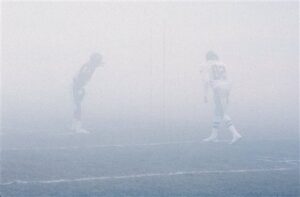 Of course, this was not the only NFL game or any football game that was affected by fog or weather. In 2017, in Foxboro, Massachusetts, the fog was so dense during a game between the New England Patriots and the Atlanta Falcons that NBC had to use its Skycam for most of the in-game coverage, instead of usual sideline cameras, which proved to be useless. As for the Fog Bowl, it was played as scheduled, because no one called it off, but I wonder if the Eagles wished they had in the end. Nevertheless, the week after the Fog Bowl, the Bears lost to eventual Super Bowl champion San Francisco in the NFC Championship Game, so I guess the game made no difference for the outcome.
Of course, this was not the only NFL game or any football game that was affected by fog or weather. In 2017, in Foxboro, Massachusetts, the fog was so dense during a game between the New England Patriots and the Atlanta Falcons that NBC had to use its Skycam for most of the in-game coverage, instead of usual sideline cameras, which proved to be useless. As for the Fog Bowl, it was played as scheduled, because no one called it off, but I wonder if the Eagles wished they had in the end. Nevertheless, the week after the Fog Bowl, the Bears lost to eventual Super Bowl champion San Francisco in the NFC Championship Game, so I guess the game made no difference for the outcome.
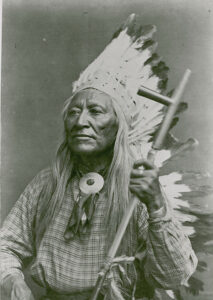 Fort Washakie was a United States Army fort located in present-day Wyoming. The fort was originally named Camp Augur in 1869, after General Christopher C Augur, who was the commander of the Department of the Platte. It was established to help protect travelers on the Overland Trail from attacks by Native Americans. As often happens, Camp Augur was renamed Camp Brown in honor of Captain Frederick H Brown in 1870. Brown was killed in the Fetterman Massacre in 1866.
Fort Washakie was a United States Army fort located in present-day Wyoming. The fort was originally named Camp Augur in 1869, after General Christopher C Augur, who was the commander of the Department of the Platte. It was established to help protect travelers on the Overland Trail from attacks by Native Americans. As often happens, Camp Augur was renamed Camp Brown in honor of Captain Frederick H Brown in 1870. Brown was killed in the Fetterman Massacre in 1866.
The fort was renamed again on December 30, 1878, in honor of Chief Washakie of the Shoshone tribe. That renaming made this fort one of the only United States military outposts to be named after a Native American. Another fort that was named for a Native American was Fort E S Parker, the original Crow Agency in Montana that operated from 1869 to 1875, which was named after the Seneca lawyer Eli Parker, who was a General under Ulysses Grant.
Fort Washakie was operated as a military outpost until 1909, when it was decommissioned and turned over to the Shoshone Indian Agency. The graves of Chief Washakie and Lewis and 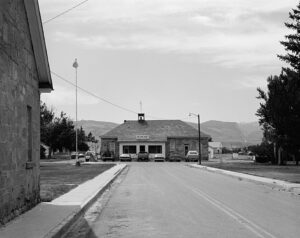
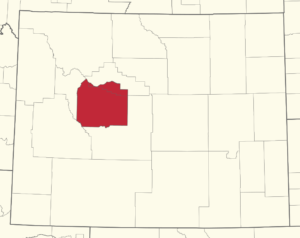 Clark Expedition guide Sacajawea are located on the grounds of the fort. The site is included within the present-day Wind River Indian Reservation. The Wind River Indian Reservation, in the west-central portion of the state of Wyoming, and it is shared by two Native American tribes, the Eastern Shoshone and the Northern Arapaho. I’ve driven through parts of the reservation every time I go to Thermopolis, but I have never been to Fort Washakie. I think maybe I should have a look sometime.
Clark Expedition guide Sacajawea are located on the grounds of the fort. The site is included within the present-day Wind River Indian Reservation. The Wind River Indian Reservation, in the west-central portion of the state of Wyoming, and it is shared by two Native American tribes, the Eastern Shoshone and the Northern Arapaho. I’ve driven through parts of the reservation every time I go to Thermopolis, but I have never been to Fort Washakie. I think maybe I should have a look sometime.
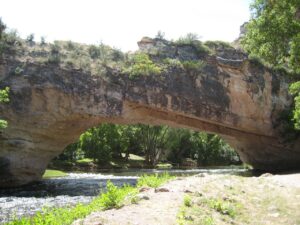 As people traveled west along the Oregon Trail and other trails, they had one thing on their minds, getting from point A to Point B…most of the time anyway. Most travelers on the Oregon Trail never strayed from their route unless they had to. That usually meant a breakdown or a sick traveler or a death. Nevertheless, once in a while, some sight would catch the eye of a traveler, or maybe they just wondered where a trail might lead, if they just went around the next bend. Whatever the case may be, they would stray off the trail a little way and find something amazing.
As people traveled west along the Oregon Trail and other trails, they had one thing on their minds, getting from point A to Point B…most of the time anyway. Most travelers on the Oregon Trail never strayed from their route unless they had to. That usually meant a breakdown or a sick traveler or a death. Nevertheless, once in a while, some sight would catch the eye of a traveler, or maybe they just wondered where a trail might lead, if they just went around the next bend. Whatever the case may be, they would stray off the trail a little way and find something amazing.
Eventually, some of the travelers found their way to a little spot about two miles south of the Oregon Trail, about 12 miles southwest of present-day Douglas, in Converse County, Wyoming. In that place, La Prele Creek flows under a large, natural arch of limestone. To add to the beauty, a dam was constructed a short way farther upstream in the early 1900s. At  around the same time a modern road was built to the site. Before all the improvements, visitors to the natural bridge had to climb down steep canyon walls and fight their way through heavy brush on the canyon floor. At that point, few people bothered, because it was just too hard to get there. For that reason, there are only a handful of accounts from that era, but from those accounts, it became clear the place left a permanent impression on those who visited the site.
around the same time a modern road was built to the site. Before all the improvements, visitors to the natural bridge had to climb down steep canyon walls and fight their way through heavy brush on the canyon floor. At that point, few people bothered, because it was just too hard to get there. For that reason, there are only a handful of accounts from that era, but from those accounts, it became clear the place left a permanent impression on those who visited the site.
The travelers who took the trip were in awe of the natural bridge that they found at the end of their long trek. All of them thought that the site was one of the most amazing places they had seen in a long time. One reporter named Matthew Field published the story of his visit to the site, including how difficult it was to get there. Nevertheless, he also told of just how “worth it” the trip was. He also mentioned that he and Sir William Drummond Stewart, who had shown him the place decided to call the creek “Bridge Creek.”

Many visitors came to visit the site over the years, but in 1910, rancher Alvah Ayres won a patent on the land. Since that time, the place has been called Ayers Natural Bridge and in 1919, his Ayers’ son donated the land to Converse County. These days it is a county park, open from April 15th to October 15th. It is a popular picnic site for many people. It is a free site and popular with rafters, waders, hikers, bicyclists, and fishermen. It is also a favorite site for outdoor weddings and company picnics. There are also a limited number of camping spots. Dogs, however, are not welcome. The site is to be kept pristine.
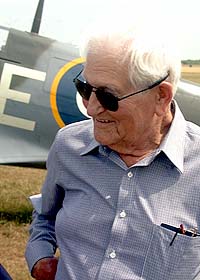 I suppose someone had to be the one…the fighter who carried out the most missions of the war. For one thing he would be the one who was fortunate enough to survive all those missions, and he would have to be the one who didn’t just go home when he finished the required number of missions to be discharged from service. For World War II, that man was Donald James Matthew Blakeslee, who was an officer in the United States Air Force. His aviation career commenced as a pilot in the Royal Canadian Air Force, flying Spitfire aircraft during World War II. Then, he joined the Air Force Eagle Squadrons, before transferring to the United States Army Air Forces in 1942. He flew more combat missions against the Luftwaffe than any other American fighter pilot, and by end of the war, he was a triple flying ace credited with 15.5 aerial victories.
I suppose someone had to be the one…the fighter who carried out the most missions of the war. For one thing he would be the one who was fortunate enough to survive all those missions, and he would have to be the one who didn’t just go home when he finished the required number of missions to be discharged from service. For World War II, that man was Donald James Matthew Blakeslee, who was an officer in the United States Air Force. His aviation career commenced as a pilot in the Royal Canadian Air Force, flying Spitfire aircraft during World War II. Then, he joined the Air Force Eagle Squadrons, before transferring to the United States Army Air Forces in 1942. He flew more combat missions against the Luftwaffe than any other American fighter pilot, and by end of the war, he was a triple flying ace credited with 15.5 aerial victories.
Blakeslee was born in Fairport Harbor, Ohio, on September 11, 1917. He developed an interest in flying early in life after observing the Cleveland Air Races as a boy. With money saved from his job the Diamond Alkali Company, he and a friend purchased a Piper J-3 in the mid-1930s and flew it from Willoughby Field, Ohio. However, his friend crashed the plane in 1940, prompting Blakeslee to decide that the best way to continue flying was to join the Royal Canadian Air Force (RCAF).
Blakeslee was trained in Canada and then sent to England on May 15, 1941. There, he was assigned to Number 401 Squadron CAF, which was part of the Biggin Hill Wing. Pilot Officer Blakeslee first saw combat on November 18, 1941, flying sweeps, when he damaged a BF-109 near Le Touquet. He claimed his first kill on November 22, 1941, a BF-109 over Desvres, about 10 miles south of Marck. On the same mission he damaged another BF-109 while returning to base. His next kills were claimed on April 28, 1942, probably destroying two FW190s. Although not a particularly good shot, he was receptive to the principles of air fighting tactics and soon proved to be a leader, both in the air and on the ground.
By the summer of 1942, he an acting flight lieutenant and was awarded the British Distinguished Flying Cross on August 14, 1942. The presentation stated that “Acting Flight Lieutenant Donald Mathew BLAKESLEE (Can.J/4551), Royal Canadian Air Force. 133 (E) Squadron. This officer has completed a large number of sorties over enemy territory. He has destroyed one, destroyed, and damaged several more hostile aircraft. He is a fine whose keenness has proved most inspiring. He then completed his first tour of duty, clocking 200 combat hours with three victories.”
Blakeslee never wanted to join the American volunteer Eagle Squadrons, because he claimed that “they exaggerated their claims.” However, when informed he was to be assigned as an instructor pilot, he volunteered to be sent to Number 133 (Eagle) RAF as its commanding officer. It was the only way to maintain his combat status. During raid Dieppe, France on August 18, 1942, Blakeslee shot down additional FW-190 and probably destroyed another on the 19th, thus achieving his first ace status. Blakeslee would go on to achieve ace status twice more, but that was not the only claim to fame he would have to his name.
On September 12, 1942, the 71st, 121st, and 133rd Squadrons were activated as the USAAF’s 4 Group, 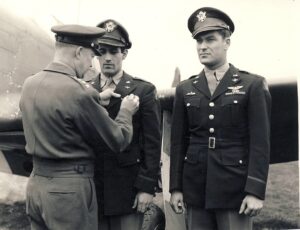 operating from a former RAF field at Debden. After a few months of flying Spitfires, the group was re-equipped with the new Republic P-47 Thunderbolt. On April 15, 1943, Blakeslee claimed an FW-190 for the group’s first P-47 kill and claimed another FW-190 on May 14, 1943, both near Knocke. Leading the 335th Squadron of the 4th Fighter Group, Blakeslee led the group into Germany the first time on July 28. Towards the end of the year, Blakeslee led the group more often and developed a tactic of circling above any air battle and so he could better direct his fighters.
operating from a former RAF field at Debden. After a few months of flying Spitfires, the group was re-equipped with the new Republic P-47 Thunderbolt. On April 15, 1943, Blakeslee claimed an FW-190 for the group’s first P-47 kill and claimed another FW-190 on May 14, 1943, both near Knocke. Leading the 335th Squadron of the 4th Fighter Group, Blakeslee led the group into Germany the first time on July 28. Towards the end of the year, Blakeslee led the group more often and developed a tactic of circling above any air battle and so he could better direct his fighters.
Blakes first flew the P-51 Mustang in December 1943 and subsequently worked diligently to have the 4th Fighter Group re-equipped with the new aircraft as soon as possible, especially after assuming command of the 4th Fighter Group on January 1, 1944. The 8th Air Force Command eventually granted the request, stipulating that the pilots must be on the P-51 within 24 hours of receiving them. Blakeslee agreed, instructing his pilots to “learn how to fly them on the way the target.”
Blakeslee piloted the first Mustang over Berlin on March 6, 1944, defending Boeing B-17s and Consolidated B24s. The 4th Fighter Group, under Blakeslee’s command, escorted the mass daylight raids of the 8th Air Force over Occupied Europe and became one of the highest-scoring groups of VIII Fighter Command. The 4th’s aggressive tactics under Blakeslee proved effective, and they surpassed the 500-kill mark by the end of April 1944. By the end of the war, the group had destroyed 1,020 German planes (550 in flight and 470 on the ground). The next landmark for Blakeslee was leading the first “shuttle” mission to Russia on June 21, 1944, flying 1,470 miles in a mission lasting over 7 hours.
In September of 1944, Don Blakeslee was finally grounded following the loss of several high-scoring USAAF aces. He had achieved 15 kills in the air two more on the ground. He had flown 500 operational sorties and accumulated 1,000 hours. Barrett Tillman, who served as an executive secretary the American Fighter Aces Association, stated that Blakeslee had more missions and hours “than any other American fighter pilot of World War II.” Blakeslee retired from the United States Force in 1965 with the rank of colonel. In his obituary in The Guardian, Blakeslee was described as “the most decorated Second World War US Air Force fighter pilot.” Blakeslee’s personal standing among Allied pilots was considerable. British ace Johnnie Johnson described him as “one of the best leaders ever to fight over Germany.”
Following the conclusion of World War II, Blakeslee continued his service in the newly established United States Air Force. During the Korean War, he commanded the 27th Fighter-Escort Group at Taegu Air Base in South Korea and Itazuke Air Base in Japan, flying several missions in the F-84 Thunderjet from December 1950 to  March 1951. In March 1963, he was promoted to colonel, and his final assignment was as Special Assistant to the Director of Operations for the Seventeenth Air Force, serving from 1964 until his retirement on April 30, 1965. After retiring, Blakeslee lived in Miami, Florida. He married Leola Fryer in 1944 and had one daughter. She passed away in 2005. Blakeslee died on September 3, 2008, at his home due to heart failure. On Friday September 18, 2008, Colonel Don Blakeslee and his wife’s ashes were interred at Arlington National Cemetery. The ceremony took place at 1100 hours and was open to the public. The 4th Fighter Wing also did a flyover at the ceremony.
March 1951. In March 1963, he was promoted to colonel, and his final assignment was as Special Assistant to the Director of Operations for the Seventeenth Air Force, serving from 1964 until his retirement on April 30, 1965. After retiring, Blakeslee lived in Miami, Florida. He married Leola Fryer in 1944 and had one daughter. She passed away in 2005. Blakeslee died on September 3, 2008, at his home due to heart failure. On Friday September 18, 2008, Colonel Don Blakeslee and his wife’s ashes were interred at Arlington National Cemetery. The ceremony took place at 1100 hours and was open to the public. The 4th Fighter Wing also did a flyover at the ceremony.
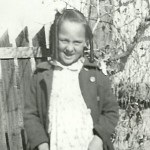
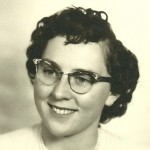 Our aunt, Esther Hein is the middle child in my father-in-law’s family, but because her mom, Vina Hein was married and divorced, Esther is the oldest of the youngest kids. In fact, because her siblings, Marion and Walt were quite a bit older than Esther, she was really the oldest for her whole young life. Of course, she always knew that Marion and Walt were her older siblings, but I expect she always thought of them more as aunt and uncle, than siblings.
Our aunt, Esther Hein is the middle child in my father-in-law’s family, but because her mom, Vina Hein was married and divorced, Esther is the oldest of the youngest kids. In fact, because her siblings, Marion and Walt were quite a bit older than Esther, she was really the oldest for her whole young life. Of course, she always knew that Marion and Walt were her older siblings, but I expect she always thought of them more as aunt and uncle, than siblings.
During her school years, Esther would often stay with my in-laws, because there were times that roads were closed, and it would have been impossible to get her to school. Of course, while my in-laws had a daughter of their own by then, she wasn’t old enough to “give them any sass” and so they may not have been used to that. It wasn’t that Esther was particularly “sassy” or anything, but kids will be kids. She and my mother-in-law, her sister-in-law, Joann Schulenberg “locked horns” a few times. I only know that because my mother-in-law told me the story. When Esther did something my mother-in-law didn’t want her to, she would tell her, “Don’t Esther!!” When I was caring for her when she had Alzheimer’s Disease, and I “made” her go to bed, she would sometimes say, “Don’t Esther!!” I figured, at least for that moment, I didn’t have to take the blame for being the bad guy!! Hahahaha!!
When I was getting ready to marry my husband, he decided that I should cut his hair. I tried to tell him that I 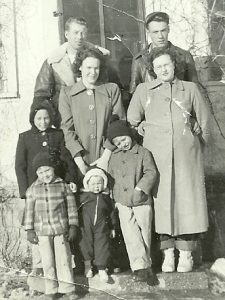
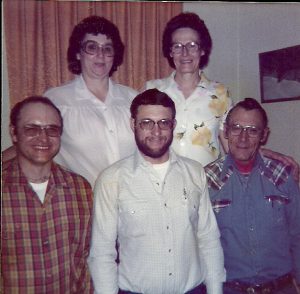 didn’t know how, but he said it was easy, just trim it. He didn’t consider that I had sisters, and the only trimming we did was straight across. So, that’s what he got. Oh…my goodness!! It was awful!! His mom fixed it, as much as was possible, and then when we were in Forsyth, Montana, visiting Grandma and Grandpa Hein at the same time as Esther was once, Bob had her cut his hair, because she was a cosmetologist. She graciously taught me how to cut a man’s hair, and since Bob was brave, he let me try again. Woo Hoo!! Success!! And today I always cut his hair. Thanks Esther!! Today is Esther’s 84th birthday. Happy birthday Esther!! Have a great day!! We love you!!
didn’t know how, but he said it was easy, just trim it. He didn’t consider that I had sisters, and the only trimming we did was straight across. So, that’s what he got. Oh…my goodness!! It was awful!! His mom fixed it, as much as was possible, and then when we were in Forsyth, Montana, visiting Grandma and Grandpa Hein at the same time as Esther was once, Bob had her cut his hair, because she was a cosmetologist. She graciously taught me how to cut a man’s hair, and since Bob was brave, he let me try again. Woo Hoo!! Success!! And today I always cut his hair. Thanks Esther!! Today is Esther’s 84th birthday. Happy birthday Esther!! Have a great day!! We love you!!
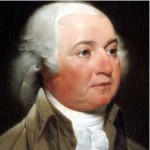
 In 1800, President John Adams approved legislation that appropriated $5,000 to purchase “such books as may be necessary for the use of Congress.” The initial collection of books, ordered from London, arrived in 1801. These were stored in the US Capitol. The books were the library’s first. The inaugural library catalog, dated April 1802, listed 964 volumes and nine maps. The library was President Adams’ pride and joy. In 1814, in what was a largely symbolic maneuver, the British entered Washington DC and burned down the capitol and the library. The fire was dramatic, but really had little relevance, because the city didn’t have an especially large population and, since much of the US government had fled before the British could overtake them, there was little strategic value in the destruction. Nevertheless, the about 3,000 books were lost in that fire.
In 1800, President John Adams approved legislation that appropriated $5,000 to purchase “such books as may be necessary for the use of Congress.” The initial collection of books, ordered from London, arrived in 1801. These were stored in the US Capitol. The books were the library’s first. The inaugural library catalog, dated April 1802, listed 964 volumes and nine maps. The library was President Adams’ pride and joy. In 1814, in what was a largely symbolic maneuver, the British entered Washington DC and burned down the capitol and the library. The fire was dramatic, but really had little relevance, because the city didn’t have an especially large population and, since much of the US government had fled before the British could overtake them, there was little strategic value in the destruction. Nevertheless, the about 3,000 books were lost in that fire.
The Library of Congress must seem like an institution that is unable to be defeated, but the reality is that while it has been there practically forever, acting as the nation’s biggest library, it has been almost destroyed three times. The Library of Congress is one of the largest libraries in the world, with over 170 million items in its collections at present, according to the Library of Congress itself. It possesses a world class collection of rare books and holds the largest known collection of audio recordings, maps, and films, among other materials. It is accessible not only to the Congressional representatives who work nearby in the Capitol, but also to all Americans and members of the public. That was not always the case, however. At its inception, the Library of Congress was for congressional use only.
Once the fires of the British died down, they left Washington, and the American lawmakers returned. As has always been the way of Americans, they knew it was time to rebuild. While Congress was putting itself back together, it became clear that most wanted the Library of Congress to return as well. At that point, former president Thomas Jefferson stepped in. He offered to sell his own library to reconstitute the one lost in 1814. It is certainly logical that Jefferson was one proposing such a deal. According to the Library of Congress, he was an avid book reader and lifelong learner with an extensive personal library. While he committed to the notion of an informed, intellectual Congress, Jefferson may have also empathized on a deeper level. In 1770, his own home had burned, and Jefferson, gazing at the ashes, most acutely felt the loss of his books. Later, he would come to possess the largest private library in the United States.
The Library of Congress faced at least three fires in its fight to exist. In fact, its existence as an institution has been challenged numerous obstacles throughout its more than 200 years of existence. The Library of Congress faced space shortages, understaffing, and lack of funding, until the American Civil War increased the importance of legislative research to meet the demands of a growing federal government. Then, in 1870, the library gained the right to receive two copies of every copyrightable work printed in the United States. It also built its collections through acquisitions and donations. Between 1890 and 1897, a new library building, which has now 
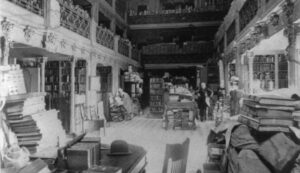 been renamed the Thomas Jefferson Building, was constructed. Two additional buildings, the John Adams Building (opened in 1939) and the James Madison Memorial Building (opened in 1980), were later added. In total, the Library of Congress has faced major fires at least three times in its history.
been renamed the Thomas Jefferson Building, was constructed. Two additional buildings, the John Adams Building (opened in 1939) and the James Madison Memorial Building (opened in 1980), were later added. In total, the Library of Congress has faced major fires at least three times in its history.
According to the United States House of Representatives, the 1825 fire occurred on the evening of December 22nd. Massachusetts Representative Edward Everett, who was leaving a nearby party, noticed a strange light coming from the library windows. When he informed a Capitol police officer, who did not have a key, Everett dismissed the situation. However, as the glow intensified, it became increasingly difficult to ignore. Eventually, more officers, along with Librarian of Congress George Watterson, discovered the dreadful truth: Library of Congress was on fire…again!!
Both representatives and firefighters fought the blaze, including’s fellow Massachusetts representative, Daniel Webster, and Tennessee politician Sam Houston. They extinguished fire before it spread to the rest of the Capitol. Ultimately, it was determined that the cause was a candle left lit in the room. The damage was not nearly as extensive as the 1814, though some books and a rug were lost.
On December 24, 1851, what is thought to be the most devastating fire destroyed 35,000 books, two-thirds of the library’s collection, and two-thirds of Jefferson’s original transfer. In 1852, Congress appropriated $168,700 to replace the books but not to acquire new materials. By 2008, the librarians of Congress had found replacements for all but 300 of the works documented as being in Jefferson’s original collection. This marked the beginning of a conservative period in the library’s administration under librarian John Silva Meehan and joint committee chairman James A. Pearce, who restricted the library’s activities. Meehan and Pearce’s views on limiting the Library of Congress’s scope were shared by members of Congress. As a librarian, Meehan and perpetuated the notion that “the congressional library should play a limited role on the national scene and its collections, by and large, should emphasize American materials obvious use to the US Congress.” In 1859, Congress transferred the library’s public document distribution activities to the Department of the Interior and its international book exchange program to the Department of State.
These days, the library is open for academic research to anyone with a Reader Identification Card. The library items may not be removed from the reading rooms or the library buildings. Most of the library’s general collection of books and journals are in the closed stacks of Jefferson and Adams Buildings. Specialized collections of books and other materials are in stacks in three main library buildings or stored off-site. Access to the closed stacks not permitted under any circumstances, except to authorized library staff and occasionally to dignitaries. Only reading room reference collections are on open shelves.
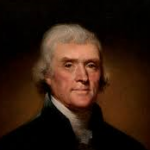
 Since 1902, American libraries have been able to request books other items through interlibrary loan from the Library of Congress, if these are not available elsewhere. Through this system, the Library of Congress has served as a “library of last resort,” according to former librarian of Congress Herbert Putnam. The Library of Congress lends books to other libraries with the stipulation that they be used only inside the borrowing library. In 2017, the Library of Congress began development of a reader’s card for children under the age of sixteen.
Since 1902, American libraries have been able to request books other items through interlibrary loan from the Library of Congress, if these are not available elsewhere. Through this system, the Library of Congress has served as a “library of last resort,” according to former librarian of Congress Herbert Putnam. The Library of Congress lends books to other libraries with the stipulation that they be used only inside the borrowing library. In 2017, the Library of Congress began development of a reader’s card for children under the age of sixteen.

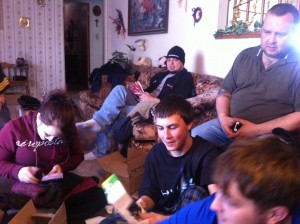 Looking back on the years of my life, or more specifically the Christmases of my life. I know that I have been very blessed. The years have changed the look of our Christmas, but not the joy. With the addition of now, great grandchildren, we have new little faces on with to see joy, and we also still have the faces of the grandchildren and the children to enjoy. Just knowing that we have brought them some Christmas cheer makes me feel so blessed.
Looking back on the years of my life, or more specifically the Christmases of my life. I know that I have been very blessed. The years have changed the look of our Christmas, but not the joy. With the addition of now, great grandchildren, we have new little faces on with to see joy, and we also still have the faces of the grandchildren and the children to enjoy. Just knowing that we have brought them some Christmas cheer makes me feel so blessed.
Some years have found us with some people in the family missing. Some have moved and some had to work. It  makes for a different kind of Christmas, but you still feel blessed that they are in your life, and that the next year will likely be different. Then, you consider those who have family serving our country far away and overseas, and you reconsider your situation in light of theirs. And you feel grateful for their service, and the sacrifice their families made so that this country can remain free.
makes for a different kind of Christmas, but you still feel blessed that they are in your life, and that the next year will likely be different. Then, you consider those who have family serving our country far away and overseas, and you reconsider your situation in light of theirs. And you feel grateful for their service, and the sacrifice their families made so that this country can remain free.
And then, there are the family members who have left us for Heaven. Those are the changes that hurt the most. The ones that can’t be reversed. Of those we just have the memories of Christmas past, when times were different, and there were no empty seats. I think the empty seats are the hardest part, whether it’s people who have left us or those who have moved. Missing them just doesn’t stop, no matter how many years have 
 gone by. Now they spend Christmas with Jesus, the one for whom we celebrate Christmas. I can’t think of a better way to spend Christmas than with Jesus himself. And I can only imagine the party!! Someday we will all see for ourselves. Until then, our memories and Christmas changes will continue to accumulate. Merry Christmas everyone. May your day be sweet and blessed, no matter where your loved ones are. And thank you to all who are serving our country far from home.
gone by. Now they spend Christmas with Jesus, the one for whom we celebrate Christmas. I can’t think of a better way to spend Christmas than with Jesus himself. And I can only imagine the party!! Someday we will all see for ourselves. Until then, our memories and Christmas changes will continue to accumulate. Merry Christmas everyone. May your day be sweet and blessed, no matter where your loved ones are. And thank you to all who are serving our country far from home.
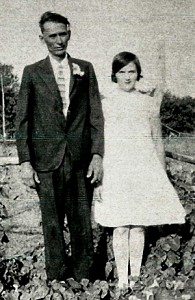 For most families, Christmas Eve is the night before the Christmas holiday. Yes, there are traditions, like maybe opening on gift, a chili dinner, caroling, or a midnight service at church. For my grandparents, Christmas Eve marked the beginning of their new life together. My grandparents, George and Hattie Byer’s, wedding anniversary made it an extraordinarily special day for our family. They were married on Christmas Eve in 1927 and today marked the 97th anniversary of that great day. For our family, this day marks the actual beginning of our very existence. Over the years, my grandparents became the parents of nine children, which led to thirty-one grandchildren, and countless great-grandchildren, great-great-grand, and great-great-great-grandchildren. My grandfather used to say, “Mommy, look what we started.” Indeed, they did! They were married for 53 years Grandpa passed away. Grandma followed eight years later, but their love has never faded. This year, as I reflect on their love for each other and the large family they created, I realize that this would have been their 97th wedding anniversary.
For most families, Christmas Eve is the night before the Christmas holiday. Yes, there are traditions, like maybe opening on gift, a chili dinner, caroling, or a midnight service at church. For my grandparents, Christmas Eve marked the beginning of their new life together. My grandparents, George and Hattie Byer’s, wedding anniversary made it an extraordinarily special day for our family. They were married on Christmas Eve in 1927 and today marked the 97th anniversary of that great day. For our family, this day marks the actual beginning of our very existence. Over the years, my grandparents became the parents of nine children, which led to thirty-one grandchildren, and countless great-grandchildren, great-great-grand, and great-great-great-grandchildren. My grandfather used to say, “Mommy, look what we started.” Indeed, they did! They were married for 53 years Grandpa passed away. Grandma followed eight years later, but their love has never faded. This year, as I reflect on their love for each other and the large family they created, I realize that this would have been their 97th wedding anniversary.
Many people might not consider Christmas Eve an ideal day for a wedding, mostly because the holiday, but many years ago, it was regarded as a suitable time for a wedding because the family 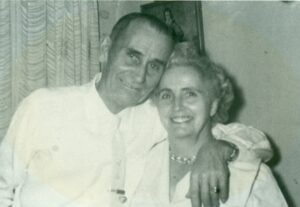 was already gathered for the holiday. Family from afar usually couldn’t travel such a distance for a wedding anyway, so it didn’t matter. People didn’t have a lot of money, so weddings were much less elaborate. The couple typically wore their Sunday best clothes and then resumed wearing them for Sunday again…no elaborate wedding gowns. Nevertheless, the love was there, and that is what mattered. Grandma and Grandpa were made for each other, and they were happy all the days of their lives. I’m sure Grandma never expected to be here without him, and I’m sure there were many lonely days after Grandpa’s passing, but she held memory in her heart and carried on for another eight years.
was already gathered for the holiday. Family from afar usually couldn’t travel such a distance for a wedding anyway, so it didn’t matter. People didn’t have a lot of money, so weddings were much less elaborate. The couple typically wore their Sunday best clothes and then resumed wearing them for Sunday again…no elaborate wedding gowns. Nevertheless, the love was there, and that is what mattered. Grandma and Grandpa were made for each other, and they were happy all the days of their lives. I’m sure Grandma never expected to be here without him, and I’m sure there were many lonely days after Grandpa’s passing, but she held memory in her heart and carried on for another eight years.
Being married on Christmas Eve is probably why Grandma and Grandpa Byer always Grandma and Grandpa Byer considered Christmas Eve to be such a special holiday. They loved the family Christmas parties. They got 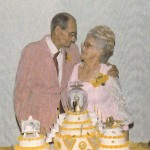
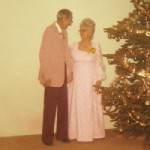 to celebrate their Anniversary and Christmas with all, or at least most, of their kids, grandkids, and great grandkids. Many of the great great grandkids and great great great grandkids these days either don’t remember or never met Grandma and Grandpa Byer, and that thought makes me sad, because they have missed out on so much. While Christmas Eve is not a common day for a wedding, it was that anniversary that always made our family feel extra blessed. Happy 97th Anniversary Grandma and Grandpa Byer. I know you are celebrating in Heaven. We love and miss you very much.
to celebrate their Anniversary and Christmas with all, or at least most, of their kids, grandkids, and great grandkids. Many of the great great grandkids and great great great grandkids these days either don’t remember or never met Grandma and Grandpa Byer, and that thought makes me sad, because they have missed out on so much. While Christmas Eve is not a common day for a wedding, it was that anniversary that always made our family feel extra blessed. Happy 97th Anniversary Grandma and Grandpa Byer. I know you are celebrating in Heaven. We love and miss you very much.
 We’ve all been there, or at least most of us. You know, the last-minute rush to get everything ready for the Christmas celebration. I suppose that is why so many people say that Christmas has become too commercialized, and maybe it has, but we love our families, and we want to do nice things for them. Still, while the actual moment of giving the gift is wonderful and exciting, the process leading up to the actual giving is a very different thing. There is shopping for people (sorry my family) who have no idea what they want and can’t think of a single idea, which leaves you wandering the store for hours trying to find that perfect gift.
We’ve all been there, or at least most of us. You know, the last-minute rush to get everything ready for the Christmas celebration. I suppose that is why so many people say that Christmas has become too commercialized, and maybe it has, but we love our families, and we want to do nice things for them. Still, while the actual moment of giving the gift is wonderful and exciting, the process leading up to the actual giving is a very different thing. There is shopping for people (sorry my family) who have no idea what they want and can’t think of a single idea, which leaves you wandering the store for hours trying to find that perfect gift.

Have you ever found yourself on Christmas morning, wrapping a gift and running it out to the waiting kids to open, and going back for another round…well, I did that once. I know…insane. That only happened once thankfully, but the story has lived on for decades, hahaha!! Well, maybe you weren’t that bad, but how about wrapping gifts at midnight on Christmas Eve, or the night before. You finally finished wrapping at about 2 or 3 in the morning, and then because you have little kids, tried to function the next day. I’m sure that sounds more familiar to a lot of people…admit it.
Then, there is Christmas morning, and the massive rush to get dinner made. Yes, you try put everything together before everyone passes out from starvation, but it is a big production. The kids are everywhere, and the noise level is deafening, but while you  would maybe like things a little quieter, you wouldn’t change having the whole family there, for anything. It’s worth every bit of the chaos, the stress, and the frustration, when you see the looks of sheer happiness and excitement on the faces of those kids.
would maybe like things a little quieter, you wouldn’t change having the whole family there, for anything. It’s worth every bit of the chaos, the stress, and the frustration, when you see the looks of sheer happiness and excitement on the faces of those kids.
The good news is that it’s almost here. Soon, Christmas will be behind us for another year, and then we can look forward to starting it all over again. We all set ourselves a goal of doing better next year, and sometimes we achieve that goal, but often as not, we find ourselves right back in the same spot next year. Nevertheless, this is the final push…better get to it.

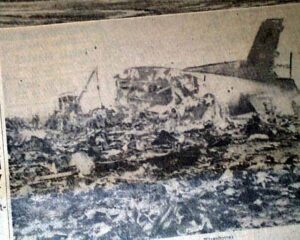 It was December 20, 1952, at the height of the Korean War. Operation Sleigh Ride…a United States Air Force airlift program to bring US servicemen who were fighting in the Korean War home for Christmas. I can imagine the excitement in the air. A chance to “take a break” from the ugliness of war even if only for a short time and spend Christmas at home. At around 6:30pm PST, the C-124 lifted off from Larson
It was December 20, 1952, at the height of the Korean War. Operation Sleigh Ride…a United States Air Force airlift program to bring US servicemen who were fighting in the Korean War home for Christmas. I can imagine the excitement in the air. A chance to “take a break” from the ugliness of war even if only for a short time and spend Christmas at home. At around 6:30pm PST, the C-124 lifted off from Larson 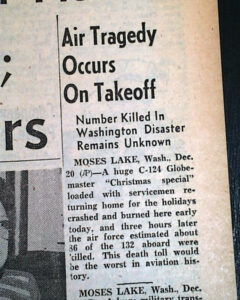 Air Force Base near Moses Lake, Washington. The plane was en route to Kelly Air Force Base, San Antonio, Texas. Then the unthinkable happened. Just seconds after taking, the left wing struck the ground, and the airplane cartwheeled, broke up, exploded, killing 82 of the 105 passengers and 5 of the 10 crew members.
Air Force Base near Moses Lake, Washington. The plane was en route to Kelly Air Force Base, San Antonio, Texas. Then the unthinkable happened. Just seconds after taking, the left wing struck the ground, and the airplane cartwheeled, broke up, exploded, killing 82 of the 105 passengers and 5 of the 10 crew members.
Investigation into the accident revealed that the aircraft’s elevator and rudder gust locks had not been disengaged prior to departure. The reports I have read did not specifically say that the accident was due to pilot error, but I also could not find information stating that is could have been mechanical failure. From that, I have to assume that the crew forgot to disengage the elevator and rudder gust locks, and the plane simply lost control.
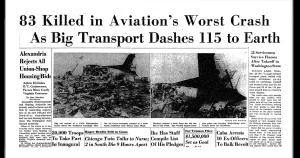 I can’t imagine the devastation of waiting at home for your soldier to come home for Christmas, only to hear that on their way home to you, they were in a crash that took their life. Of course, they wanted their soldier home for Christmas, but my guess is that many carried the weight of that desire for years. If their soldier had stayed in Korea, they might have later come home from the war alive. It was all just too much to bear. This would be the deadliest crash in history, until the Tachikawa air disaster, which also involved a Douglas C-124A-DL Globemaster II and claimed 129 lives. Of course, no crash that involves loss of life, is a minor thing. The devastation the families feel is beyond comprehension.
I can’t imagine the devastation of waiting at home for your soldier to come home for Christmas, only to hear that on their way home to you, they were in a crash that took their life. Of course, they wanted their soldier home for Christmas, but my guess is that many carried the weight of that desire for years. If their soldier had stayed in Korea, they might have later come home from the war alive. It was all just too much to bear. This would be the deadliest crash in history, until the Tachikawa air disaster, which also involved a Douglas C-124A-DL Globemaster II and claimed 129 lives. Of course, no crash that involves loss of life, is a minor thing. The devastation the families feel is beyond comprehension.

